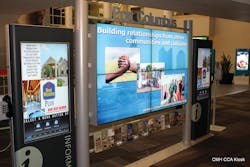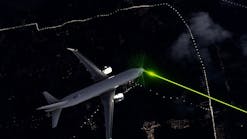PULLQUOTE: Many passengers travel within a “technology cocoon” that began to develop years ago with laptops and is now virtually complete with smartphones and tablets.
Connecting with passengers in a busy airport environment is critical to facility owners--not only to provide directional and flight information, but also to maximize non-aviation revenue generation through advertising and marketing opportunities, communicate safety and regulatory messages, and provide information about the community beyond the four corners of the airport. Making these connections is not as easy as it seems, however. Competing messages from a variety of digital platforms, and even the behavior patterns of the travelers’ themselves, complicate this task.
Many passengers travel within a “technology cocoon” that began to develop years ago with laptops and is now virtually complete with smartphones and tablets. Within this cocoon, passengers tend to focus on these devices and less on their surrounding environment. This technology cocoon represents an imaginary surface that is different than airports are traditionally accustomed to addressing.
There are two options to help airports penetrate this technology cocoon. The first strategy addresses utilizing mobile platforms to engage passengers within their cocoons. The second focuses on developing facility kiosks to help draw passengers out of them. Both methods directly engage passengers, and provide information, marketing, and even entertainment, as they move through the terminal.
Get smart about smartphones
Recent surveys show approximately 90 percent of airline passengers carry at least one smartphone. It is safe to assume--through direct observation--that many also carry multiple digital devices. Based on this, airports should consider pushing information directly to passengers on their mobile devices.
Airports can take advantage of this trend by designing web pages tailored to mobile devices or by utilizing apps designed specifically for the airport industry (or the specific airport). Scaled down web pages or airport focused apps typically supply the same information delivered via traditional in-terminal signage. For example, Clear Channel Airports’ FlySmart app contains detailed terminal maps that help users locate their position in an airport, find a nearby restaurant, track a flight, and locate ground transportation. It also generates advertising revenue for the airport by integrating advertising into the app. All of this information transfers through the technology cocoon directly to passengers on their smartphones or tablets.
Community Connections
Airports should also consider connecting with passengers outside their technology cocoons by providing opportunities for them to interact with digital signage within the airport. Interactive kiosks are one form of digital signage that grabs passengers’ attention and encourages their direct engagement. Like mobile technology, interactive kiosks allow the user to choose what information to display at any given time. But unlike mobile devices, interactive kiosks remain static in the facility. The advantage is these kiosks allow information to be presented in a large format; accessed directly by users in the facility; pushed out to passengers, either through print or to mobile devices; and used to connect passengers to social media.
The Port Columbus International Airport (CMH) installed two versions of interactive kiosks in 2012. Clear Channel Airports completed the first installation as a replacement to its existing digital courtesy phone board. The new kiosks provided bright, responsive ads for hotels, ground transportation, and other local amenities and attractions. Like Clear Channel Airports’ old phone boards, these interactive kiosks contained detailed information on each paying client. But unlike the previous boards, upon direct input from the passenger, these kiosks included a “text to phone” feature to replace legacy printers. This new level of integration passengers enabled passengers to easily access information from their mobile devices.
The Columbus Regional Airport Authority’s customer service team managed the second installation of interactive kiosks at CMH, which was completed in late 2012. These interactive kiosks replaced static information directories. The airport-owned interactive kiosks grab passenger interest through a combination of location and vibrant graphics. Some kiosks were placed in areas where the old static directories once sat, but whenever possible these kiosks were moved into the passenger flow of the terminal. Rotating graphics highlighting community activities help draw passengers to the kiosks. As with static signs, the units offer way-finding via a map, but unlike static signs, they also incorporate graphically detailed directions and estimated walking times. The kiosks also offer checkpoint information, weather details, advertising elements, and terminal concession marketing in an easily navigated, interactive format.
At the kiosks, users can select from several available languages to find needed information. They also can print or send key information to their mobile device by scanning a QR code on the screen. Finally, to maximize user engagement, passengers can utilize the kiosk’s “photo and frame” feature to photograph themselves, and then load the image to their phone to email to others or upload to various social media platforms.
Break Out of Your Techno Cocoon
These are just a couple solutions designed to help airports connect with passengers in today’s terminal environment. There are, however, many other options available. But in a sea of ever-changing options, the challenge often becomes sifting through mounds of information to find the right vendor or service for your facility.
To help airports break out of their own industry cocoons, futurist James Canton suggested at a recent conference that airports wishing to stay abreast of emerging trends look beyond the standard industry resources. A potential resource is the Digital Signage Federation (DSF), a leading trade group that provides an international trade show dedicated to digital signage. DSF also provides access and information on interactive technology, out-of home networks, webinars, case studies, guides to getting started with digital signage, as well as training and certification opportunities via its web site at www.digitalsignagefederation.org).
Reaching passengers hiding out in their technology cocoons is critical part of airport business. But it’s possible to utilize both the technology they carry and the technology provided in the terminal environment to keep the lines of communication open.
BIO: David Saleme, A.A.E., joined the Columbus Regional Airport Authority (CRAA) in October 1996. He was hired under the General Counsel's office, with a focus on concessions and real estate. During his time with CRAA, he has been responsible for terminal and concession development at Port Columbus International Airport, part of which includes terminal advertising and marketing. Saleme’s primarily responsible for managing the in-airport advertising program, which includes, in addition to the award-winning video wall system, more than 20 additional digital advertising screens throughout the terminal, and the external digital billboard program. Saleme also negotiates and drafts concession agreements, bid packages, requests for proposal, land and building leases, airline lease amendments, minimum standards, and other agreements with airport tenants and operators.



